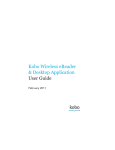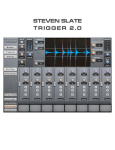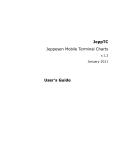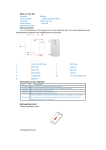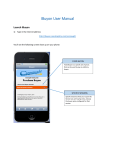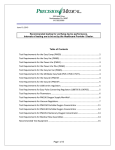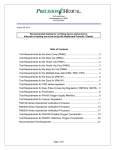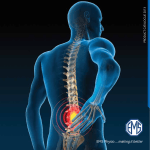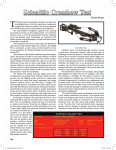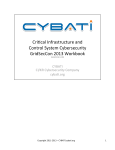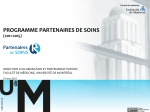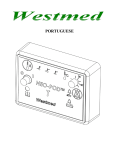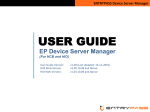Download System Instructions for Use.
Transcript
Vibralung® Acoustical Percussor™ Instruc(ons for Use Indica(ons for Use. The Vibralung AcousEcal Percussor is indicated as an airway secreEon clearance device that creates vibraEons in the airways and as a lung expansion device that applies PosiEve Expiratory Pressure (PEP) as a paEent breathes through the device. It may be used to promote bronchial drainage, airway clearance and expectoraEon and to prevent or reverse atelectasis. The Vibralung may be used simultaneously with aerosol drug delivery. Pa(ent Popula(on. CysEc Fibrosis, COPD, asthma and lung diseases with secretory problems, paEents with neuromuscular disease affecEng the ability to effecEvely cough, and paEents with or at risk of developing atelectasis. Anyone who is able to read and/or follow verbal instrucEons. Environment of Use. Hospital and home. Contraindica(ons. ACT or use of the Vibralung AcousEcal Percussor, especially with PosiEve Expiratory Pressure, may be contraindicated in paEents who have untreated air leaks, tension pneumothorax, bronchopleural fistula, recent hemoptysis, or pulmonary hemorrhage as it may exacerbate those condiEons. Prescribers should weigh the benefits against the risks in paEents with these condiEons. Adverse Reac(ons. If the paEent complains of dry throat or mouth brought about by treatment with the Vibralung, consider adding nebulizaEon with normal saline if it is not already being done. If the paEent complains of sore mouth, jaw or teeth brought about by using the Vibralung device, the healthcare pracEEoner should assess the paEent. If the paEent complains of dizziness or light-‐headedness, assess the paEent for possible hypervenElaEon while using the device. If the paEent appears to be hypervenElaEng, pause the treatment and coach the paEent to alter their breathing paYern appropriately. Any other adverse reacEons should be fully assessed before conEnuing therapy with the Vibralung AcousEcal Percussor. Westmed, Inc. ◆ 5580 S. Nogales Highway ◆ Tucson, AZ 85706 ◆ 800.975.7987 ◆ www.westmedinc.com Vibralung Acous(cal Percussor® Instruc(ons for Use DEVICE DESCRIPTION The Vibralung AcousEcal Percussor® is used for airway clearance therapy and helps paEents with lung disease to clear mucus and phlegm from their lungs through the use of sound waves. The paEent simply breathes through a mouthpiece aYached to the “Hand Held Transducer,” or HHT, while holding on to the handle. The HHT is connected to a small baYery-‐operated electronic box called the “Treatment Control Unit” or TCU. The TCU generates the sound waves and controls the treatment. See the pictures and instrucEons inside this pamphlet before operaEng. WARNINGS! PATIENT INJURY OR INEFFECTIVE THERAPY CAN RESULT FROM IMPROPER ASSEMBLY OR OPERATION. READ THE FOLLOWING WARNINGS BEFORE ASSEMBLING OR OPERATING DEVICE • Federal law restricts this device to sale by or on the order of a physician. • Read this InstrucEons for Use manual before use. • Unskilled or untrained personnel should not operate or apply this device to paEents. • Use only as intended and described in this manual and supporEng documentaEon • Use only on cooperaEve paEents who can properly self-‐administer following training. • Use only with the supplied mouthpiece and accessory adapters. • Be prepared to help paEent with removal of secreEons (cough coaching, sucEon) as needed. • The HHT, Cone and related Y-‐adapters are for single paEent use, mulEple treatment sessions during single hospitalizaEon and should be changed as directed. • Do not hold Hand-‐Held Transducer up to your ear. Hearing damage may result. Foam ear plugs are provided to lessen the sound to which your ears are exposed. Wear the ear plugs during each treatment. • Do not connect or interface the Vibralung AcousEcal Percussor to any airway clearance device or aerosol delivery system other than the Westmed Circulaire® II or Circulaire II Hybrid™ aerosol drug delivery system and Westmed Variable Expiratory Resistor for PosiEve Expiratory Pressure (PEP) because other devices have not been designed or ascertained to funcEon properly with the inspiratory and exhalaEon gas flow pathways of the Vibralung. CAUTIONS • • • • • • • • Do not open or aYempt to disassemble either the TCU or the HHT. There are no user-‐serviceable parts inside. Internal baYeries are not user-‐serviceable. The TCU must be returned to Westmed for service. The HHT is disposable and, if it is damaged, it should be discarded and replaced. Do not over-‐Eghten the “Cone” onto the HHT. Ensure the outlet port of the Cone is properly aligned and the outlet port on the Cone should be aligned to the “3 o’clock” posiEon. See inset diagrams on page 4. Do not use the TCU and HHT in extremely moist and humid environments such as a shower or outside during rain. Do not immerse the TCU or the HHT in liquid or allow liquid to seep into the case. Do not aYempt to disinfect either the HHC or the TCU with boiling water, steam, baby boYle sterilizers, dishwashers or microwave ovens. Use only the BaYery Charger that is supplied with the TCU. Use of a different charger may damage the baYeries and/or the electronics. Do not operate the Vibralung AcousEcal Percussor in potenEally explosive, highly flammable or oxygen-‐ enriched atmospheres such as an operaEng room during use of flammable anestheEcs or in an oxygen tent, croup tent, head hood or incubator with oxygen flowing. Do not use the Vibralung AcousEcal Percussor with a facemask of any kind because of the uncertainty of coupling the acousEc energy to the airways. Page 2 INCLUDED PARTS The Vibralung AcousEcal Percussor is supplied in two boxes. One box holds the reusable Treatment Control Unit (A), Pole-‐mount Bracket (B), and BaYery Charger (C). The other box holds the disposable Hand-‐held Transducer assembly (D) plus Standard Y-‐adapter, mouthpiece and Variable Expiratory Resistor (E), plus an Aerosol Y-‐adapter (F) that can be used for aerosol delivery. You should have all the following parts (images not to scale): A" B" C" ! ! ! ! ! ! ! ! Treatment Control Pole-‐mount Bracket (pole not included) Unit ( TCU) BaQery Charger ! ! E" F" ! Mouthpiece ! ! Variable Expiratory ! Resistor Inspiratory ! for PEP Valve ! (purple cap) ! ! ! Aerosol Y-‐adapter Standard Y-‐adapter ! ! D" Screw-‐on Cone Handle Hand-‐held Transducer (HHT) A cable (not shown) emerges from the boYom of the handle for connecEng the HHT to the TCU PREPARING THE TCU FOR FIRST USE Follow these steps to charge, test and set up the Treatment Control Unit (TCU) for the first (me. 1. Remove the TCU (A), Pole-‐mount Bracket (B) and BaYery Charger (C) from their shipping box. 2. Mount the TCU on any pole between ¾ and 1¼ inch in diameter using the supplied Pole-‐mount Bracket as shown in the figure above. Alternately, simply set the TCU on a flat surface. 3. Plug the BaYery Charger into a standard 120 volt electrical outlet and plug the end of the baYery charger cable into the boYom jack on the len side of the TCU. (The BaYery Charger plug will not fit in the top jack on the len side of the TCU). All 9 Light Emipng Diodes (LEDs) should flash 3 Emes quickly and then the Charging and Power LEDs should stay on during the charging process. 4. Leave the BaYery Charger plugged in and connected to the TCU unEl the TCU’s internal baYeries are fully charged (which should take no more than 4 hours). The Charging LED will go out and the Power LED will flash when the unit is fully charged. 5. Disconnect the BaYery Charger aner baYeries are charged, as the TCU will not operate while the charger is connected. 6. Aner charging is completed and the charger is disconnected from the TCU, perform a Power On Self Test (POST) to verify that the TCU sonware and processor is operaEng properly: Turn the TCU on by pressing the Power control buYon once. The POST will occur immediately as shown by all 9 LEDs flashing 3 Emes. If the TCU passes the POST, the Pause and Power LEDs will remain illuminated. If other LEDs are illuminated, or if no LEDs are illuminated, the TCU failed the POST and should not be used. Contact Westmed Customer Service (see page 10). 7. The Treatment Control Unit (TCU) is now ready for use. Repeat these steps every Eme the baYery needs to be recharged, as indicated by the Low BaYery LED. Page 3 HHT ASSEMBLY WITHOUT AEROSOL The assembled Vibralung AcousEcal Percussor Hand-‐held Transducer (HHT) is shown below. This assembly uses the Standard Y-‐adapter (E). Connect the long end of the Standard Y-‐adapter to the cone. The mouthpiece should be at the other end and the Variable Expiratory Resistor should be on the tail of the Y. The outlet port of the cone should be at the 3 o’clock posiEon as you are facing it, and the assembly should be aligned as shown in the “user’s view” below: User’s View, “3 o’clock” alignment HHT ASSEMBLY WITH AEROSOL If simultaneous aerosol therapy is required, obtain and aYach the Circulaire II Hybrid aerosol delivery system as shown below. Remove the Standard Y-‐adapter (E), replace with the Aerosol Y-‐adapter (F), and transfer the mouthpiece to the Aerosol Y-‐adapter. Insert the Circulaire II Hybrid aerosol delivery system on to the tail of the Aerosol Y-‐adapter as shown. The outlet port of the cone should be at the 3 o’clock posiEon as you are facing it, and the assembly should be aligned as shown in the ‘Bird’s Eye View’ below: Bird’s Eye View Operate the nebulizer with oxygen or compressed air. Adjust the opening of the Variable Expiratory Resistor to apply PEP. See the Circulaire II or Circulaire II Hybrid package insert for further instrucEons for use. Page 4 BUTTONS AND SETTINGS ON THE TCU The TCU has 2 electrical jacks on the len side panel. The top jack is for connecEng the TCU to the Hand-‐held Transducer (HHT) and the boYom jack is for connecEng the BaYery Charger. Seven user-‐selectable buYons contain LEDs that illuminate when pressed. The buYons also make a “clicking” feeling to provide tacEle feedback when they are pressed. These buYons enable the user to select from 5 control sepngs as shown in the legend below, as well as a “Start/Pause” funcEon and Power On/Off. AddiEonally, two LED indicators (“Charging” and “Low BaYery”) illuminate as needed to show the status of the internal baYery. Connect HHT here Connect BaYery Charger here Note: The TCU will not operate while the BaEery Charger is plugged into it. Button&Label& Action! Control!button!to!select!“Low”!frequency!setting!(5!–!200!Hz).!! ! Control!button!to!select!“Medium”!frequency!setting!(5!–!600!Hz).&& !! Control!button!to!select!“High”!frequency!setting!(5!–!1,200!Hz).!! !! Control!buttons!to!select!either!a!2G!or!5Gminute!period!of!Random!Noise.!! !! Control!button!to!Start,!Pause!or!Resume!a!treatment!session.!! !! Control!button!to!turn!the!TCU!on!or!off.! !! ! Page 5 OPERATING INSTRUCTIONS Refer to physician’s prescrip(on or caregivers instruc(ons for appropriate seZngs for the Vibralung Acous(cal Percussor. Regardless of which Y-‐adapter is used, opera(on of the Vibralung Acous(c Percussor is the same. The pa(ent should hold the device in one or both hands while inser(ng the mouthpiece into the mouth and breathing normally throughout the treatment. 1. Power. To power on the TCU, disconnect it from the charger, plug the HHT into it, and then press the Power On/Off buYon. • The LEDs embedded in the Power and Start/Pause buYons illuminate. • The Low BaYery LED illuminates if the baYery is in need of recharging. • The Unit is in Pause mode upon powering on. 2. Mode Selec(on. To select and acEvate a sepng, • Press one of the 5 sepng buYons in the top row (L, M, H, R2 or R5). -‐ The LED embedded in the selected sepng buYon illuminates. • Press the Pause buYon to acEvate the device and emit sound at the selected sepng. -‐ The LED embedded in the Pause buYon exEnguishes. • Unless stopped or paused, the unit will operate at the selected sepng for 10 minute and then terminate. • Press the Pause buYon at any Eme while acEvated to pause the session. -‐ The LED embedded in the Pause buYon illuminates. • Press the Pause buYon while paused to resume the session. -‐ The LED embedded in the Pause buYon exEnguishes. Charging & Low BaQery LEDs • If a paused session is not resumed within 2 minutes by pressing the Pause buYon again, the session automaEcally terminates. Important: If a different treatment mode is desired before the currently selected mode has terminated, it is necessary to power the TCU off, then power it on again and select the desired mode. 3. Resume, Terminate, Repeat. To resume an automaEcally terminated session, or repeat a session with the same sepngs, or start a different session with different sepngs, repeat steps 1 and 2 above and select the appropriate sepngs. 4. Treatment. To take the treatment, the paEent should place the mouthpiece in his or her mouth and seal their lips around it just Eghtly enough to maintain a comfortable seal. The teeth may rest gently on the mouthpiece but the paEent should be cauEoned to not bite down or chew on the son plasEc mouthpiece. 5. Pa(ent Posi(on. Avoid recumbent paEent posiEoning while using the Vibralung AcousEcal Percussor. PaEent should be sipng upright or at no more than a 30° recumbent angle to facilitate coughing and expectoraEon. 6. Breathing PaQern. The paEent should breathe normally during the treatment. As with any breathing treatment, hypervenElaEon or excessively deep or fast breathing may result in dizziness or light-‐headedness. The treatment may be paused at any Eme and resumed if the paEent needs to rest. 7. Posi(ve Expiratory Pressure (PEP) Therapy. Adjust the Variable Expiratory Resistor to apply PEP during resEng breathing. Minimal PEP is applied when the orifice is wide open (60°) and maximal PEP when the orifice is at the minimal posiEon (10°). An opEonal PEP manometer is available so that PEP levels can be monitored. Minimal PEP levels will be observed during quiet Edal breathing due to relaEvely low respiratory flowrates. If desired, the paEent may be instructed to perform an extended PEP maneuver by taking a deep breath and then exhaling slowly while maintaining an expiratory flowrate sufficient to keep the PEP manometer in the 10 to 20 cmH2O pressure range for 3 to 5 seconds. This maneuver can be repeated 10 to 20 Emes or as onen as desired for the paEent. Page 6 TREATMENT SETTINGS A selected treatment sepng with the Vibralung AcousEcal Percussor takes up to 10 minutes, depending upon the sepng that has been selected, and provided the session has not been paused at any Eme. Five sepngs, represenEng a designated sequence of frequency ranges, have been programmed into the Treatment Control Unit as shown in the following table: A treatment session may consist of the applicaEon of one or more sepngs, depending upon the target area(s) of the lungs to which therapy should be directed, paEent preference and paEent response to therapy. In theory, lower frequency tones are effecEve on larger, wider airways while higher frequency tones are effecEve on smaller, thinner airways. TherapeuEc benefit(s) may not necessarily be rendered on the first treatment, or even the first few treatments. It may require an indeterminate number of treatment sessions, 2 to 4 Emes daily, before benefits become apparent. SIMULTANEOUS AEROSOL THERAPY The Circulaire II Hybrid aerosol delivery system may be used with the Vibralung AcousEcal Percussor if wepng agents or inhalaEon medicaEons are prescribed. The Circulaire II Hybrid is the only nebulizer system approved for use with the Vibralung AcousEcal Percussor. The Vibralung includes an Aerosol Y-‐adapter that allows connecEng the Circulaire II Hybrid to the HHT, as shown in the boYom figure on page 4. The Circulaire II Hybrid, when aYached to the Vibralung AcousEcal Percussor with the Aerosol Y-‐adapter, provides a direct pathway for inhalaEon and exhalaEon. The Aerosol Y-‐adapter provides a direct pathway for the sound waves to travel through to enter the mouth and the lung. In this manner, the acousEcal energy remains coupled to the paEent’s lungs during inhalaEon and exhalaEon while the aerosol treatment is taking place. Further, PEP therapy can also be administered by way of the Circulaire II Hybrid, which has a Variable Expiratory Resistor on the exhalaEon port. Finally, because many of the paEents who may benefit from airway clearance therapy and aerosol therapy with the Vibralung AcousEcal Percussor also have pulmonary infecEons, an exhalaEon filter is included in the exhalaEon pathway of the Circulaire II Hybrid to prevent medicaEons and paEent droplets from being emiYed into the room and possibly inhaled by caregivers or other paEents. WARNING -‐ Do not connect or interface the Vibralung Acous(cal Percussor to any airway clearance device or aerosol delivery system other than the Westmed Circulaire® II or Circulaire II Hybrid™ aerosol drug delivery system and/or Westmed Variable Expiratory Resistor for Posi(ve Expiratory Pressure (PEP) because other devices have not been designed or ascertained to func(on properly with the inspiratory and exhala(on gas flow pathways of the Vibralung. Page 7 TROUBLESHOOTING [ conEnued next page … ] Page 8 TROUBLESHOOTING PROBLEM( TCU$becomes$very$hot$to$the$touch.$ Case$components$of$the$TCU$case$become$loose$or$ separate$altogether.$ Case$components$of$the$HHT$become$loose$or$ separate$altogether.$ $ Interface$cable$between$the$TCU$and$HHT$becomes$ damaged$from$the$HHT,$or$the$miniBplug$becomes$ damaged.$ $ Patient$or$caregiver$unable$to$assemble$parts;$i.e.,$ parts$do$not$seem$to$fit$together$or$mate$properly.$$ $ Variable$Expiratory$Resistor$for$PEP$and/or$Circulaire$ II$Hybrid$for$aerosol$therapy$do$not$seem$to$fit$ properly.$ $ Unable$to$attach$nonBWestmed$nebulizer$or$PEP$ device$to$the$Vibralung$Acoustical$Percussor.$ $ CARE, CLEANING AND DISPOSAL SOLUTION(S)( Discontinue$use$immediately$and$contact$ Westmed$Customer$Service.$ $ Retighten$screws$if$all$are$present.$If$some$screws$ are$missing,$contact$Westmed$Customer$Service.$ $ Discard$faulty$disposable$unit$and$replace$with$a$ new$HHT.$ Discard$faulty$HHT$and$replace$with$a$new$HHT.$ Refer$to$Instruction$Manual$to$confirm$proper$ parts.$$ Inspect$parts$for$physical$damage$or$deformation$ (e.g.,$outBofBround,$rough$edges).$Replace$parts$ that$have$been$damaged.$ $ Refer$to$Instruction$Manual$to$confirm$proper$YB adapter$and$orientation.$$$ Inspect$parts$for$physical$damage$or$deformation$ (e.g.,$outBofBround,$rough$edges).$Replace$parts$ that$have$been$damaged.$ $ Use$only$the$Westmed$Circulaire$II$or$Circulaire$II$ Hybrid$for$aerosol$therapy$and$Westmed$Variable$ Expiratory$Resistor$for$PEP.$ $ $ !The TCU should undergo surface disinfecEon on a daily basis* to minimize surface contaminaEon. Clean all external surfaces of the TCU with a pre-‐moistened germicidal wipe product such as Clorox® DisinfecEng Wipes. Be sure to allow the appropriate contact Eme as specified by the product's instrucEons. Ensure that moisture does not enter the case of the TCU at the seams or at the two electrical jacks. The control buYons on the faceplate are sealed against moisture entry. The HHT should undergo cleaning and disinfecEon on a daily basis* to remove possible accumulaEon of secreEons and to minimize surface contaminaEon. To clean the HHT, first remove the Y-‐adapter, mouthpiece, variable expiratory resistor and screw-‐on cone. Wash these parts with soap and warm water, rinse with sterile water then disinfect by soaking in a soluEon of 1 part household bleach and 50 parts water for 3 minutes. Spread all parts on a clean paper towel to air dry. Also remove the Circulaire, if present, and clean it according to its instrucEons. Do not immerse the handle or speaker part of the HHT in any liquid. Clean the outside surface of the HHT and the transducer diaphragm with a pre-‐moistened germicidal wipe product such as Clorox® DisinfecEng Wipes. Allow the appropriate contact Eme as specified by the product's instrucEons. Allow to dry before reassembling and using. The disposable HHT and all associated plasEc parts may be discarded into the usual waste stream in accord with local regulaEons. The TCU contains a lithium-‐ion baYery pack, which, in most states, can be disposed of via normal waste management procedures. If in doubt, please check your local regulaEons. * Westmed recommends cleaning and disinfecEon at the end of each treatment day. Page 9 TECHNICAL SPECIFICATIONS [ conEnued next page … ] Page 10 TECHNICAL SPECIFICATIONS Page 11 ELECTROMAGNETIC EMISSIONS AND ENVIRONMENT Page 12 PARTS AND ACCESSORIES SERVICE • For any unexpected change in normal operaEon, suspected malfuncEon, or failure of the device, contact the Westmed Customer Service Department at the telephone number below. • Prior to considering service, be sure to review the TroubleshooEng secEon above. • Only the Treatment Control Unit (TCU) can be serviced. There are no serviceable parts in the disposable Hand-‐held Transducer (HHT). • Westmed, Inc. is the only authorized service center available for diagnosing or repairing the Vibralung AcousEcal Percussor TCU, replacing its internal baYeries, or replacing the enEre TCU. • To iniEate a service request, please contact the Westmed Customer Service Department and request a Returned Goods AuthorizaEon (RGA) Number prior to returning the device(s) for service. • Place the RGA Number on the outside of the shipping package when returning goods to Westmed. • Any device received by Westmed without an RGA Number will be returned to sender. • When packaging for return, please perform disinfecEon on the TCU according to the Care and Cleaning InstrucEons on page 9, then place it in a plasEc bag and surround with packaging peanuts, bubble wrap or crushed paper for addiEonal protecEon. Westmed, Inc. / Customer Service 5580 South Nogales Highway Tucson, AZ 85706-‐3333 (800) 975-‐7987 Page 13 Safety and Informa(onal Symbols For further informa(on, scan this QR code with your smart phone or tablet for the comprehensive Online User Manual, or browse to: www.westmedinc.com/VL_Manual Copyright © 2013 Westmed, Inc. All rights reserved. Vibralung® and Vibralung AcousEcal Percussor® are registered trademarks of VibraLung, Inc. Circulaire® is a registered trademark of Westmed, Inc. Circulaire II Hybrid™ is a trademark of Westmed, Inc. PN 71944 Rev 01 Page 14 Westmed, Inc. 5580 S. Nogales Highway Tucson, AZ 85706 800.975.7987 www.westmedinc.com














